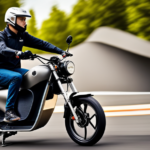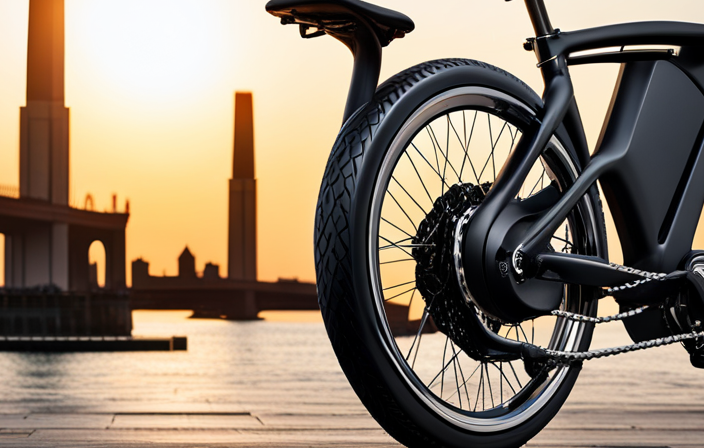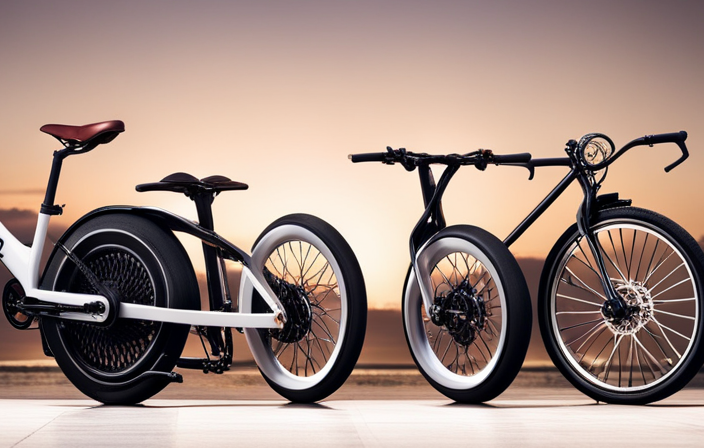Did you know that the right battery can significantly enhance the performance of your electric bike? With so many options available, it can be overwhelming to choose the perfect one.
But fear not, because in this article, I will guide you through the process of picking the right battery for your electric bike. We will explore the different types of batteries, consider factors like capacity, voltage, and size, as well as delve into important considerations such as charging time and environmental impact.
So let’s dive in and find the battery that suits your riding style and needs!
Key Takeaways
- Battery Lifespan and Maintenance: A reliable Battery Management System (BMS) is essential for extending battery lifespan and ensuring safety and longevity.
- Warranty, Support, and Reliability: Consider the length of coverage, customer reviews, and manufacturer confidence in technical specifications for reliable warranty and support.
- Price, Value for Money, and Long-term Investment: Compare the cost, capacity, and lifespan of batteries to make a long-term investment. Energy efficiency is also important for maximizing performance.
- Environmental Impact and Proper Disposal: Choose batteries made from sustainable materials and follow local guidelines for proper disposal and recycling. Responsible disposal contributes to a cleaner environment.
Understanding the Different Types of Electric Bike Batteries
There are three main types of electric bike batteries: lead-acid, lithium-ion, and nickel-metal hydride.
When it comes to e-bike battery lifespan, the type of battery you choose plays a significant role. Lead-acid batteries are the most affordable option but have the shortest lifespan, typically lasting around 300-500 charge cycles.
On the other hand, lithium-ion batteries are more expensive but offer a longer lifespan, ranging from 500-1000 charge cycles. Nickel-metal hydride batteries fall somewhere in between, with a lifespan of around 500-800 charge cycles.
Additionally, it’s essential to consider the impact of temperature on battery performance. Extreme heat or cold can affect the battery’s capacity and overall performance. Therefore, it’s crucial to store and charge your e-bike battery in a temperature-controlled environment whenever possible.
Considering the battery capacity is the next step in selecting the right battery for your electric bike.
Consider the Battery Capacity
When considering the battery capacity for an e-bike, it’s important to make sure it meets your specific needs. The battery life of an electric bike can greatly impact your overall riding experience, so it’s crucial to choose a battery that can provide sufficient power for your desired distance and terrain.
Here are three key factors to consider when evaluating battery capacity:
-
Range: Determine the distance you typically ride and choose a battery that can support that range without needing frequent recharging. This will ensure you won’t run out of power during your rides.
-
Battery maintenance: Look for batteries that require minimal maintenance and are easy to charge. Opting for a battery with a longer lifespan and higher charging efficiency will save you time and effort in the long run.
-
Weight: Consider the weight of the battery as it can affect the overall weight of the bike. A lighter battery will make your e-bike more agile and easier to handle.
By carefully considering these factors, you can select a battery that maximizes your riding experience and meets your specific needs.
Now, let’s dive into the next section about voltage and power output, which plays a crucial role in determining the performance of an electric bike.
Voltage and Power Output
To ensure optimal performance for your e-bike, you should consider the voltage and power output of the battery.
The voltage of an e-bike battery determines the speed and power at which it can deliver energy to the motor. Higher voltage batteries generally provide more power and better acceleration. However, it’s important to balance this with the power efficiency of the battery. A battery with higher voltage may consume more power, reducing its overall efficiency.
Additionally, the power output of the battery affects the range and duration of your e-bike rides. It’s crucial to choose a battery with sufficient power output to meet your needs without compromising the battery lifespan.
To maximize battery lifespan and maintain optimal performance, it’s recommended to follow proper charging and maintenance practices.
Now, let’s discuss weight and size considerations when selecting an e-bike battery.
Weight and Size Considerations
Choosing a lightweight and compact battery is essential for maximizing your e-bike’s portability and maneuverability. When considering battery weight, it’s important to find a balance between power and convenience. A heavier battery may offer more capacity and longer range, but it can also make your bike heavier and harder to handle.
On the other hand, a lighter battery may be easier to carry and install, but it might have a shorter range. Battery size is another crucial factor to consider. A smaller battery can be more discreet and fit seamlessly into your e-bike’s frame, while a larger battery may provide more power and longer rides. Finding the right balance between weight and size will ultimately depend on your specific needs and preferences.
Now, let’s explore the next aspect of choosing the right battery: charging time and compatibility.
Charging Time and Compatibility
Make sure you consider the charging time and compatibility of your e-bike’s battery. These factors play a crucial role in the overall performance and convenience of your electric bike. When it comes to charging time, you’ll want to choose a battery that can be quickly recharged, allowing you to spend more time riding and less time waiting for your battery to charge. Compatibility is also essential to ensure that the battery fits seamlessly into your e-bike’s design and power requirements. To help you make an informed decision, here’s a table summarizing the charging time and compatibility of different e-bike batteries:
| Battery Type | Charging Time | Compatibility |
|---|---|---|
| Lithium-ion | 3-5 hours | Most e-bikes |
| Lead-acid | 6-12 hours | Older models |
| Nickel-metal hydride | 4-6 hours | Some e-bikes |
| Lithium polymer | 2-4 hours | Advanced models |
| Lithium iron phosphate | 4-6 hours | Safety-focused models |
Considering the battery lifespan and safety features is crucial when selecting the right battery for your e-bike. A longer battery lifespan ensures that you can enjoy your electric bike for years to come without needing frequent replacements. Additionally, opt for batteries with safety features such as overcharge protection and thermal management systems to prevent accidents and extend the overall lifespan of your battery. With these factors in mind, let’s now explore the importance of a battery management system (BMS) in the next section.
Battery Management System (BMS)
Now that we’ve covered the importance of charging time and compatibility, let’s dive into another crucial aspect of choosing the right battery for an electric bike: the Battery Management System (BMS).
The BMS is a vital component that ensures the safety and longevity of the battery. Here are three key things to consider when it comes to the BMS:
-
Battery Protection: The BMS protects the battery from overcharging, overheating, and over-discharging. It constantly monitors the battery’s voltage, temperature, and current to prevent any potential damage or hazards.
-
Balancing Cells: The BMS ensures that all the cells in the battery pack are balanced, meaning that they have an equal charge level. This helps to maximize the battery’s capacity and overall performance.
-
Battery Lifespan: By managing the charging and discharging process, the BMS helps to extend the battery’s lifespan. It prevents overcharging and deep discharging, which can degrade the battery over time.
With a reliable BMS in place, you can have peace of mind knowing that your electric bike’s battery is being properly managed for optimal safety and longevity.
Now that we understand the importance of the Battery Management System, let’s move on to the next section: warranty and support.
Warranty and Support
When it comes to warranty and support, you’ll want to consider the length of the coverage and the level of customer service provided. It’s important to choose a battery for your electric bike that not only performs well but also comes with reliable warranty and support options. Customer reviews can give you valuable insights into the reliability of a battery’s warranty and support. Additionally, checking the technical specifications of the battery can also provide information about the manufacturer’s confidence in their product. To help you make an informed decision, here is a table comparing the warranty and support features of three popular electric bike batteries:
| Battery Brand | Warranty Length | Customer Service |
|---|---|---|
| Brand A | 2 years | Excellent |
| Brand B | 1 year | Good |
| Brand C | 3 years | Average |
Considering the warranty length and level of customer service, you can choose a battery that suits your needs. Now, let’s move on to discussing the price and value for money of electric bike batteries.
Price and Value for Money
When it comes to electric bike batteries, comparing cost and performance is essential. As a knowledgeable consumer, I want to make sure I’m getting the best value for my money.
Additionally, I also consider the long-term investment aspect, as I want a battery that will last and provide reliable performance for years to come.
Comparing Cost and Performance
To compare the cost and performance of different batteries for your electric bike, you’ll want to consider factors such as price, capacity, and lifespan.
When it comes to battery lifespan, it’s crucial to choose a battery that can withstand frequent charging and discharging cycles without losing its capacity. Opting for a battery with a longer lifespan will save you money in the long run, as you won’t have to replace it as often.
Additionally, energy efficiency is another important factor to consider. A battery that efficiently converts stored energy into power will allow you to ride longer distances and maximize your bike’s performance.
Long-term Investment
By carefully evaluating these factors, you can ensure that your investment in a battery will be profitable in the long run. One of the most important considerations in electric bike maintenance is the battery lifespan. A battery with a longer lifespan will save you money and reduce the hassle of frequent replacements. Look for batteries designed for electric bikes and with a good durability track record. Consider factors like battery type, capacity, and charging time as they impact lifespan. Proper maintenance and care, such as avoiding extreme temperatures and regular charging, can enhance battery longevity. Choosing a long-lasting battery and taking good care of it ensures a payoff in the long run.
Now, let’s consider the environmental impact of your battery choice.
Consider the Environmental Impact
When it comes to eco-friendly battery options for electric bikes, there are a few key factors to consider.
First, it’s important to choose a battery that is made from sustainable materials and has a low environmental impact.
Additionally, proper disposal and recycling of batteries is crucial to prevent harmful chemicals from entering the environment.
Eco-friendly Battery Options
There’s a variety of eco-friendly battery options available for electric bikes. As technology advances, so does the development of eco-friendly battery technologies. Here are four options to consider:
-
Lithium-ion batteries: These are the most commonly used batteries for electric bikes due to their high energy density and long lifespan.
-
Nickel-metal hydride (NiMH) batteries: While not as efficient as lithium-ion batteries, NiMH batteries are more environmentally friendly and easier to recycle.
-
Lead-acid batteries: These batteries have been around for a long time and are known for their low cost. However, they are heavy and have a shorter lifespan.
-
Fuel cell batteries: These batteries use hydrogen to generate electricity and produce only water vapor as a byproduct, making them extremely eco-friendly.
When considering eco-friendly battery options for your electric bike, it’s important to also consider sustainable battery manufacturing practices and the impact of the entire battery lifecycle, from production to disposal and recycling.
Proper Disposal and Recycling
To ensure you are properly disposing and recycling your eco-friendly batteries, it’s crucial to follow local guidelines and regulations. Disposal regulations for batteries are in place to protect the environment and prevent any harm that may arise from improper handling.
When it comes to e-waste management, batteries are considered hazardous due to the toxic materials they contain. Many communities have designated drop-off points or recycling programs specifically for batteries. It’s important to check with your local waste management authority to find out the specific regulations in your area.
By responsibly disposing of your batteries, you are contributing to a cleaner and safer environment.
Now, let’s transition into the next section where we will discuss how to pick the right battery for your electric bike, taking into account your riding style and needs.
Take into Account Your Riding Style and Needs
Consider your riding style and needs when choosing the right battery for your electric bike. The battery range is an important factor to consider, as it determines how far you can travel on a single charge. Battery technology has advanced significantly in recent years, offering different options with varying capacities and charging times.
To help you make an informed decision, I have created a table that compares three popular battery types based on their range and technology:
| Battery Type | Range (Miles) | Technology |
|---|---|---|
| Lithium-ion | 40-100 | High energy density, lightweight |
| Nickel-metal Hydride (NiMH) | 20-60 | Affordable, longer lifespan |
| Lead-acid | 15-40 | Low cost, heavy |
Understanding your riding style and needs will guide you in choosing the right battery. If you frequently embark on long rides, a lithium-ion battery with high energy density and a range of 40-100 miles may be ideal. On the other hand, if you have a limited budget and shorter commutes, a lead-acid battery with a range of 15-40 miles could be a suitable option. It’s important to consider factors such as weight, cost, and charging time when making your decision.
Frequently Asked Questions
Are there any safety precautions I should take when handling or charging an electric bike battery?
When it comes to battery safety and charging tips for an electric bike, there are a few precautions to keep in mind. Always handle the battery with care, avoid overcharging, and use the charger specifically designed for your bike’s battery.
Can I upgrade or replace the battery on my electric bike?
Yes, you can upgrade or replace the battery on your electric bike. Upgrading the battery capacity allows for longer rides, and replacing the battery technology can provide benefits such as improved performance and increased lifespan.
How long does the battery typically last before it needs to be replaced?
The battery lifespan of an electric bike varies depending on factors such as usage, charging habits, and battery quality. On average, a battery can last between 2 to 5 years before needing to be replaced.
Are there any maintenance tasks I need to perform regularly to keep the battery in good condition?
Regular battery maintenance is crucial to ensure a long battery lifespan. From keeping it clean and dry to avoiding extreme temperatures, following these simple tasks will help keep your battery in top condition.
Can I use a battery from a different brand or model on my electric bike?
Using different battery brands on an electric bike can lead to compatibility issues with different battery models. It’s important to stick with the recommended battery brand and model to ensure optimal performance and avoid potential damage.
Conclusion
In conclusion, choosing the right battery for your electric bike is crucial for optimal performance and longevity. By considering factors such as battery capacity, voltage and power output, weight and size, charging time and compatibility, warranty and support, price and value for money, environmental impact, and your riding style and needs, you can make an informed decision.
Did you know that the average lifespan of an electric bike battery is around 2-3 years? This statistic emphasizes the importance of choosing a battery that is durable and reliable.
So, make sure to do your research and select the perfect battery for your electric bike!
















